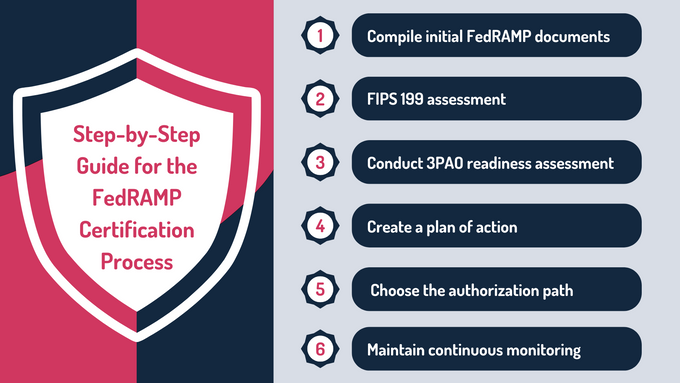What Is FedRAMP Certification? Made Simple for Cloud Providers
Understanding what it means to be FedRAMP certified is essential for cloud providers targeting federal agencies. This blog breaks down the FedRAMP process, common challenges, and how to prepare for certification with practical guidance.
Published June 2, 2025.

If you’re a cloud service provider (CSP) working with U.S. federal agencies, you’ve likely heard of the Federal Risk and Authorization Management Program (FedRAMP). The process involves paperwork, security rules, and government steps. Managing cloud safety through FedRAMP can feel overwhelming. Whether you’re just starting or planning your next move, knowing what to focus on makes a big difference.
In this blog, we’ll explain what FedRAMP certification involves, what it means to be FedRAMP certified, the steps to get there, and how to avoid common pitfalls.
» New to cloud security? Contact our experts for a customized and rigorous compliance audit
What Is FedRAMP?
FedRAMP is a U.S. government-wide initiative that standardizes the security assessment, authorization, and continuous monitoring of cloud services.
Who Needs to Be FedRAMP Compliant?
- Cloud providers working with federal agencies: Any cloud provider delivering services to U.S. federal agencies must meet FedRAMP standards, including third-party vendors that store, transmit, or process government data.
- Federal agencies using cloud services: All federal agencies must use FedRAMP-authorized solutions for cloud-based IT systems rated at low-impact or higher.
- Organizations handling federal information: This includes government contractors, service providers, or staffing firms that interact with or manage federal data.
- Software companies selling to the government: Vendors offering SaaS, PaaS, or IaaS solutions to government clients are required to ensure their services are FedRAMP compliant.
» Learn more: What is compliance and why do you need it?
Benefits of Achieving FedRAMP Certification
- Boost visibility with federal agencies: FedRAMP certification positions your cloud service as a trusted partner, increasing your chances of working with U.S. government clients. A listing in the FedRAMP Marketplace makes it easier for agencies to find and evaluate your solution.
- Detect security gaps early in the process: The FedRAMP Ready phase helps identify weaknesses before formal assessment begins. This proactive approach reduces surprises later and gives you time to plan effective remediation.
- Improve efficiency across authorizations: Organizing your documentation early and reusing security assessments across multiple agencies saves time and effort. It also shortens onboarding timelines for federal clients.
- Strengthen your overall security posture: Meeting FedRAMP’s strict controls improves how your organization handles risk. It enhances consistency and reliability across your cloud environment.
- Build lasting trust with government clients: FedRAMP signals long-term commitment to cybersecurity. It shows federal partners that your cloud service takes compliance seriously and can be trusted with sensitive data.
» Learn more: What is good compliance and how to get started
FedRAMP JAB vs. Agency ATO
Cloud service providers pursuing FedRAMP compliance can follow one of two authorization paths: the Joint Authorization Board (JAB) or the Agency Authorization to Operate (ATO). Each route has its own scope, cost, and strategic value, depending on your service model and target federal clients.
| Category | JAB (Joint Authorization Board) Path | Agency Authorization to Operate (ATO) Path |
|---|---|---|
| Overview | Overseen by the General Services Administration (GSA) and the Chief Information Officers of the Department of Defense and the Department of Homeland Security, this path provides a Provisional ATO for moderate or high-impact systems. | Involves direct collaboration between a CSP and a single federal agency to achieve ATO. Often used for low-impact systems under FIPS 199. |
| Difficulty | More rigorous and standardized. Approval is required from all three Chief Information Officers. Only 12 CSPs are accepted per year. | Generally less difficult. Some mandatory steps, such as the Third Party Assessment Organization (3PAO) Readiness Assessment Report, are optional. The process is tailored to agency needs. |
| Cost | Higher costs due to formal security assessments and centralized review requirements. | Typically less costly. CSPs save time and resources by customizing the process with a single agency and avoiding redundant documentation. |
| Strategic Value | Offers broad government-wide recognition. The Provisional ATO can be reused by multiple agencies, streamlining approval for cross-agency cloud solutions. | Valuable for CSPs focused on specific agency contracts or niche use cases. Enables faster, more targeted authorizations based on agency priorities and systems. |
| Who Uses It? | Used by CSPs offering scalable, cross-agency services that require a widely recognized FedRAMP certification. Best suited for vendors pursuing broad federal adoption. | Preferred by CSPs working with the Department of Veterans Affairs (VA), Department of Health and Human Services (HHS), and the U.S. Department of Agriculture (USDA). Ideal for agency-specific solutions. |
» Here's everything you need to know about mastering cloud security
Three FedRAMP Impact Levels
FedRAMP categorizes cloud services into three impact levels: Low, Moderate, and High. These levels reflect the potential consequences of a breach in confidentiality, integrity, or availability. Each level carries different security expectations, data sensitivity thresholds, and typical use cases.
Low Impact
Low-impact cloud services handle data where a breach would cause limited harm to agencies. They mostly cover publicly available or minimally sensitive info like names and emails. These services support simple websites or apps with basic security needs.
Key aspects:
- These require about 156 baseline security controls designed to protect low-risk data.
- Unauthorized access or service disruption would have minimal impact on agency operations.
- These systems are also designed to avoid processing sensitive personally identifiable information, which helps reduce overall risk.
Moderate Impact
Moderate-impact services manage sensitive data where breaches could cause serious harm like financial loss or identity theft. They cover business processes and customer data and require stricter security controls.
Key aspects:
- Approximately 323 security controls must be implemented to safeguard moderate-risk information.
- The systems must undergo full FedRAMP audits to ensure compliance with security requirements.
- These services are often used for financial management, customer data, and business-critical operations.
High Impact
High-impact services protect critical government systems where breaches could lead to severe or catastrophic consequences. They handle highly sensitive unclassified data and require robust security and monitoring.
Key aspects:
- These support essential functions, including law enforcement, emergency response, and national security.
- High-impact systems demand continuous monitoring and comprehensive security controls.
- Classified information is generally kept within government-managed environments, not cloud services.
» Be prepared: Learn about key cybersecurity considerations for international businesses
Step-by-Step Guide for the FedRAMP Certification Process
1. Compile Initial FedRAMP Documents
To begin the FedRAMP certification process, organizations must gather and review official templates and guidance from the FedRAMP website. These documents support every phase including preparation, authorization, and continuous monitoring.
2. FIPS 199 Assessment
FIPS 199, developed by NIST, classifies the sensitivity of the information a cloud service handles as low, moderate, or high impact. This classification sets the baseline security controls a CSP must follow. Most CSPs working with federal agencies fall under the moderate category.
Remember: Higher impact levels require stricter security measures to ensure proper protection of federal data.
3. Conduct 3PAO Readiness Assessment
A Third-Party Assessment Organization performs a cybersecurity review and produces a Readiness Assessment Report (RAR).
This report is mandatory for the JAB path and highly recommended for the Agency path.
Even if optional, this assessment identifies security gaps, establishes a risk baseline, and creates remediation plans. Taking this step early helps simplify the FedRAMP process and improves the chances of success.
4. Create a Plan of Action and Milestones (POA&M) and Execute
The POA&M, derived from NIST SP 800-53, is a critical FedRAMP requirement that outlines how an agency or CSP will address security gaps. It details remediation steps and timelines for any deficiencies identified during assessments.
Even if immediate remediation isn't possible, documenting action plans and target dates demonstrates a commitment to risk mitigation and compliance. Remediation efforts should follow a structured schedule, with progress regularly tracked and documented.
» Discover how a vCISO can guide your compliance and risk mitigation strategy
5. Follow the Agency or JAB Process for Authorization
After preparing initial documentation and assessments, FedRAMP authorization follows two paths:
- The JAB Process: This requires CSPs to complete a 3PAO Readiness Assessment, a Full Security Assessment, and remediation before obtaining a Provisional Authorization to Operate (P-ATO).
- Agency Process: This allows CSPs to work directly with a federal agency. The 3PAO Readiness Assessment is optional, and the process leads to an Authorization to Operate (ATO) after security assessment and remediation.
6. Maintain Continuous Monitoring
After obtaining an ATO or P-ATO, organizations must maintain continuous monitoring to stay FedRAMP compliant. This includes providing monthly or annual evidence that key controls like vulnerability scanning and penetration testing are operational.
Automating controls, such as scheduled vulnerability scans and immediate backup of security logs, helps simplify continuous monitoring, ensuring consistent compliance and efficient risk management.
» See how hackers exploit security vulnerabilities: Learn about the benefits of penetration testing
Common Challenges Cloud Service Providers Face When Pursuing FedRAMP Authorization
Understanding the FedRAMP Process
- Challenge: FedRAMP is one of the strictest federal frameworks. It includes detailed documentation, technical security controls, and continuous monitoring. Every step is reviewed and validated. Many CSPs struggle to keep up with the process and meet all the expectations.
- Solution: Create a clear plan from the start. Break the process into stages like readiness, assessment, and authorization. Use the FedRAMP templates and follow official guidance. The better your preparation, the smoother the path to authorization.
Selecting the Right FedRAMP Partner
- Challenge: Choosing an inexperienced partner can lead to delays, missed details, and compliance setbacks. Many CSPs struggle without guidance on audits, documentation, and security requirements.
- Solution: Choose a partner with proven FedRAMP experience. Make sure they understand the process from start to finish. This makes the journey smoother and helps you stay on track long-term.
Determining Your Market and Finding a Sponsor
- Challenge: Before starting FedRAMP, you need to know which federal agencies are the right fit for your product. That means finding one that supports your service and is willing to sponsor your authorization. This step can take time and is often a major roadblock.
- Solution: Start building relationships early. Go to industry events. Engage with the FedRAMP PMO. Respond to RFPs that match your solution. The sooner you connect with the right agency, the faster you can move forward with your FedRAMP journey.
» Do you have a startup? Here are some cyber tips to improve your security
How GRSee Consulting Helps Your Business With FedRAMP Certification
When you start the FedRAMP certification process, GRSee Consulting is there from the first step. We begin with a detailed cloud security assessment to measure your current security posture against FedRAMP requirements. Then we build a custom plan to fix any gaps while keeping your operations running smoothly and your costs in check. We guide you through readiness, pre-audit, and audit phases, making the complex process easier to manage.
Our continued support ensures your cloud service stays compliant, even as standards evolve, helping your business build long-term trust with federal agencies.
» Secure your path to FedRAMP certification—contact GRSee today





